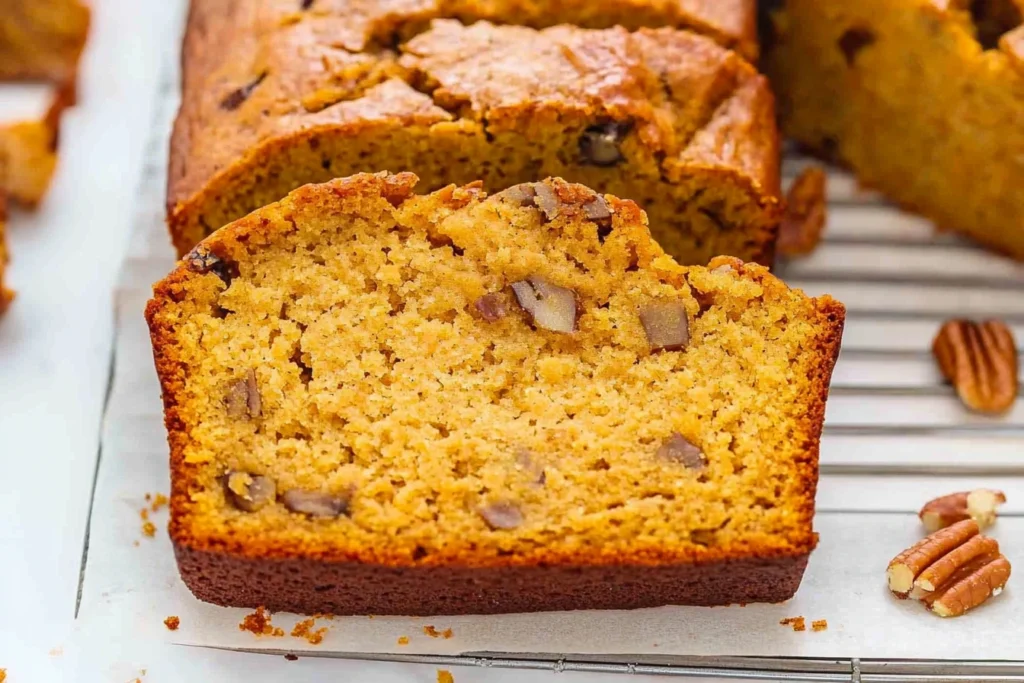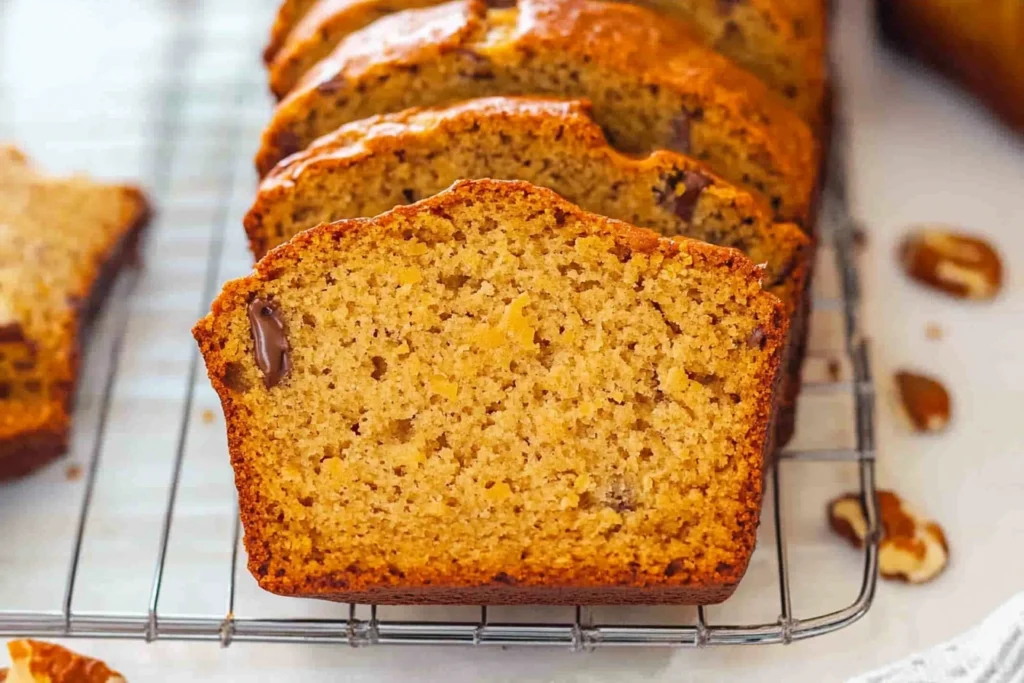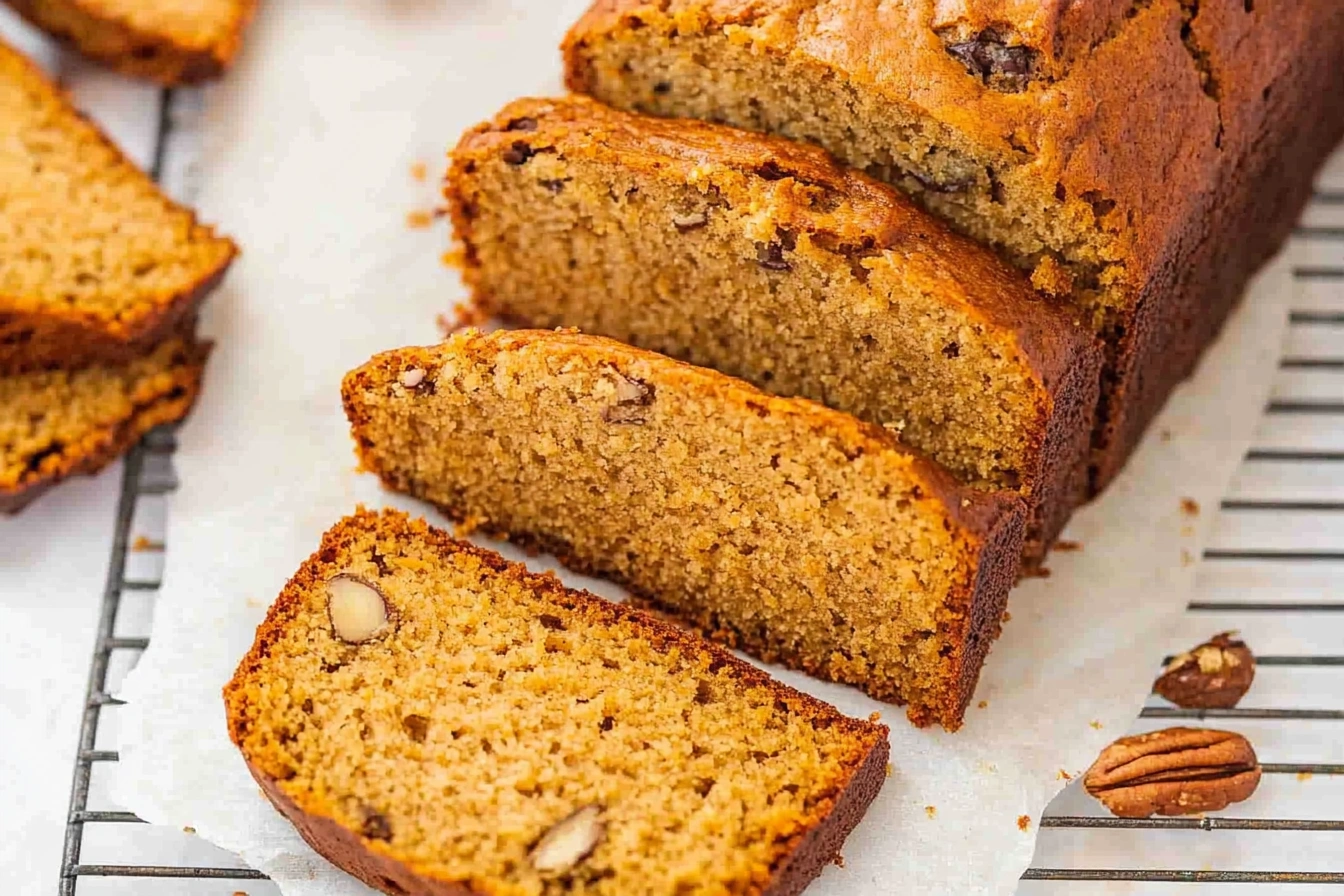Sweet potato bread is a culinary delight that’s both comforting and versatile. Whether you’re looking for a moist and flavorful treat to share at gatherings or a healthier bread option, this recipe has something for everyone. In this article, we’ll walk you through every aspect of making sweet potato bread, from the perfect blend of ingredients to creative variations. You’ll also find tips for storing, serving, and even making your loaf more nutritious. Let’s dive in and discover how to make this scrumptious bread a part of your routine!
Introduction
What Is Sweet Potato Bread?
Sweet potato bread is a quick bread that combines the earthy sweetness of mashed sweet potatoes with traditional baking ingredients like flour, sugar, and spices. Unlike its yeast-based cousins, quick bread doesn’t require rising time, making it an ideal option for busy bakers. It has a tender crumb and a naturally sweet flavor, thanks to the sweet potatoes.
Interestingly, this bread has been a favorite in Southern kitchens for generations, often enjoyed during the fall and winter months. Its vibrant orange hue and inviting aroma make it a showstopper on any table. And while sweet potato bread bears similarities to banana or pumpkin bread, its unique flavor and nutritional benefits set it apart.
Why Sweet Potato Bread Is So Popular
There are plenty of reasons why this bread enjoys such widespread popularity. For starters, sweet potatoes are not just tasty; they’re incredibly nutritious. Packed with fiber, vitamins, and antioxidants, they add both health benefits and a creamy texture to the bread.
This bread’s versatility is another reason it stands out. You can enjoy it plain, spiced with cinnamon and nutmeg, or even studded with nuts and chocolate chips for extra decadence. Whether served as a snack, dessert, or breakfast option, it’s always a crowd-pleaser.

Ingredients and Substitutions
Core Ingredients for Sweet Potato Bread
The magic of sweet potato bread lies in its simple, wholesome ingredients. Here’s what you’ll need to whip up a delightful loaf:
- Sweet Potatoes: These are the star of the show! Opt for orange-fleshed varieties like Beauregard or Jewel for a naturally sweet and moist bread. Make sure they’re cooked and mashed until smooth.
- Flour: All-purpose flour works well for a light texture, but you can also use whole wheat flour for a denser, more fiber-rich loaf. For gluten-free options, a 1-to-1 gluten-free baking mix will do the trick.
- Sweeteners: Most recipes call for white or brown sugar, but you can substitute with honey, maple syrup, or coconut sugar for a natural twist.
- Eggs and Butter: These add richness and structure. If you’re aiming for a plant-based loaf, no worries—there are excellent alternatives!
Ingredient Substitutions and Variations
Let’s say you’re missing an ingredient or want to experiment a little. No problem—this bread is forgiving enough to handle substitutions without compromising taste or texture.
- Vegan Swaps: Replace eggs with flaxseed or chia seed gel (1 tablespoon of seeds mixed with 3 tablespoons of water equals one egg). Instead of butter, coconut oil or plant-based margarine works wonders.
- Add-ins: Want to jazz things up? Toss in a handful of chopped pecans, dried cranberries, or dark chocolate chips. These additions add texture and bursts of flavor that make each bite exciting.
- Healthier Choices: For a lower-calorie loaf, consider replacing some sugar with mashed bananas or unsweetened applesauce.
Step-by-Step Recipe Guide
How to Make Sweet Potato Bread from Scratch
Making this recipe is a straightforward process that doesn’t require advanced baking skills. Follow these steps for a loaf that’s perfectly moist and flavorful every time.
Preparing the Sweet Potatoes
The foundation of any great sweet potato bread is perfectly cooked and mashed sweet potatoes. Here’s how to prep them:
- Roasting Method: Roast whole sweet potatoes in their skins at 400°F (200°C) for about 45 minutes or until fork-tender. Roasting intensifies their natural sweetness.
- Boiling Method: Peel and cube sweet potatoes, then boil them in salted water for 20 minutes until soft. Drain well to avoid excess moisture.
Once cooked, mash the sweet potatoes thoroughly or puree them for a smoother texture. Allow them to cool before incorporating them into your batter.
Mixing the Batter
Now comes the fun part—combining the ingredients!
- Dry Ingredients: In a large bowl, whisk together your flour, baking powder, baking soda, salt, and spices like cinnamon and nutmeg. This ensures even distribution of leavening agents and spices.
- Wet Ingredients: In a separate bowl, mix your mashed sweet potatoes, sugar (or alternative sweetener), eggs, melted butter, and vanilla extract. Blend until smooth.
- Combine: Gradually fold the dry ingredients into the wet mixture. Stir gently—overmixing can lead to dense bread. If you’re adding nuts or chocolate chips, incorporate them at this stage.
Baking and Cooling
- Prepare the Pan: Grease and flour a standard loaf pan or line it with parchment paper for easy removal.
- Bake: Pour the batter into the pan and bake in a preheated oven at 350°F (175°C) for 50–60 minutes. Check for doneness by inserting a toothpick into the center—it should come out clean or with a few moist crumbs.
- Cool: Let the bread cool in the pan for 10 minutes before transferring it to a wire rack. Cooling ensures the bread firms up and slices neatly.
Advanced and Variations
Ready to experiment? Try these exciting twists on the classic recipe:
- Spiced Sweet Potato Bread: Add cloves, ginger, or allspice to your batter for a warming, aromatic loaf.
- Savory Sweet Potato Bread: Swap out sugar for grated Parmesan cheese and add herbs like thyme or rosemary. This variation pairs beautifully with soups or stews.

Storage and Serving Suggestions
How to Store Sweet Potato Bread
Proper storage ensures that your sweet potato bread stays moist and delicious for days. Here’s how to keep it fresh:
- Room Temperature: If you plan to consume the bread within 2–3 days, wrap it tightly in plastic wrap or store it in an airtight container. Keep it in a cool, dry place away from sunlight.
- Refrigeration: For longer storage, refrigerate the bread. Wrap it securely to prevent it from drying out and enjoy it within a week.
- Freezing: Sweet potato bread freezes exceptionally well! Slice it first for convenience, then wrap each piece in plastic wrap and place them in a freezer-safe bag. Thaw individual slices at room temperature or warm them in the oven for that freshly baked feel.
Shelf Life: How Long Does It Stay Fresh?
- At room temperature: 2–3 days.
- In the refrigerator: Up to 7 days.
- In the freezer: Up to 3 months.
Creative Ways to Serve Sweet Potato Bread
This recipe is a versatile treat that can shine in many ways. Here are some serving suggestions to elevate your loaf:
- Breakfast Boost: Toast slices and top them with cream cheese, almond butter, or a drizzle of honey for a quick, satisfying breakfast.
- Dessert Delight: Serve it warm with a dollop of whipped cream or a scoop of vanilla ice cream for a decadent dessert.
- Savory Pairings: Pair savory variations with soups, stews, or salads for a hearty meal.
- Tea-Time Treat: Enjoy it plain alongside your favorite tea or coffee for a cozy afternoon snack.
With these storage and serving ideas, you can extend the life of your bread while keeping things exciting on your plate!
Health Benefits of Sweet Potato Bread
Nutritional Profile of Sweet Potato Bread
Sweet potato bread offers a delightful balance of flavor and nutrition. Thanks to its key ingredient, sweet potatoes, it packs a nutritional punch while still feeling indulgent. Here’s a breakdown of what makes it such a smart choice:
- Calories: While calorie content depends on the recipe, a standard slice is moderate in calories, making it a guilt-free snack.
- Carbohydrates: Sweet potatoes provide complex carbs, offering sustained energy without a sugar crash.
- Fiber: With fiber from sweet potatoes and optional whole wheat flour, this bread supports healthy digestion.
- Vitamins and Minerals: It’s rich in vitamin A, thanks to beta-carotene, and provides essential nutrients like vitamin C, potassium, and magnesium.
Why Sweet Potato Bread Is a Healthy Choice
If you’re trying to balance health and indulgence, sweet potato bread is a win-win. Here’s why:
- Naturally Sweetened: Sweet potatoes reduce the need for added sugar while adding natural sweetness.
- Low in Fat: By using plant-based oils or minimal butter, the bread remains light yet flavorful.
- Gluten-Free Friendly: With a gluten-free flour blend, this bread accommodates dietary restrictions without sacrificing taste.
- Perfect for Special Diets: Vegan variations, dairy-free tweaks, and sugar-free substitutions make this bread accessible for a wide range of dietary preferences.
Comparison with Traditional Bread Options
Unlike traditional white bread, which often lacks nutritional value, sweet potato bread provides key nutrients in every bite. It’s not just a filler food—it’s a functional choice that satisfies cravings while offering health benefits.
Sweet potato bread isn’t just a tasty treat; it’s a nourishing way to enjoy the goodness of whole foods in a convenient, delicious form.

Frequently Asked Questions (FAQs)
Can diabetics eat sweet potato bread?
Yes, diabetics can enjoy sweet potato bread in moderation, especially if it’s made with low-glycemic sweeteners like stevia or coconut sugar. Sweet potatoes themselves have a relatively low glycemic index compared to other starchy foods, making them a better option for blood sugar control. However, it’s essential to monitor portion sizes and consult a healthcare provider when making dietary decisions.
What are the benefits of sweet potato bread?
Sweet potato bread is not only delicious but also nutritious. It provides essential vitamins like A and C, minerals such as potassium and magnesium, and dietary fiber for better digestion. The sweet potatoes add natural sweetness, reducing the need for excess sugar, and they contain antioxidants that promote overall health. Additionally, it’s a versatile recipe that can cater to gluten-free, dairy-free, and vegan diets.
What is sweet potato bread made of?
It’s typically made from simple ingredients like mashed sweet potatoes, flour, sugar, eggs, butter or oil, and baking spices such as cinnamon or nutmeg. Optional add-ins like nuts, raisins, or chocolate chips can enhance the flavor and texture. It’s a quick bread, meaning it doesn’t require yeast, which makes it easy and fast to prepare.
Why do you soak sweet potatoes before baking?
Soaking sweet potatoes before baking can help remove excess starch, which improves their texture and allows them to cook more evenly. While it’s not a necessary step for making this recipe, it can be helpful if you’re using the potatoes in other dishes or want a smoother puree for your batter.
Conclusion:
Sweet potato bread is more than just a baked treat; it’s a heartwarming combination of flavor, nutrition, and versatility. Whether you prefer it spiced, savory, or with a touch of sweetness, this bread adapts to suit your preferences. Packed with vitamins, fiber, and antioxidants, it’s a wholesome choice that doesn’t compromise on taste.
From preparing the perfect sweet potato puree to serving it creatively, every step of making this bread adds to its charm. So why wait? Gather your ingredients, preheat the oven, and treat yourself to the comforting joy of homemade sweet potato bread today.
Explore More Delicious Recipes:
Cheeseburger Egg Rolls: A Delicious Fusion of Flavorful Snacks
Juicy and Healthy Air Fryer Turkey Burgers: A Complete Guide


1 thought on “Sweet Potato Bread: A Step-by-Step Guide to This Delicious Treat”